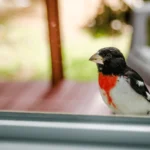
Continúa la batalla judicial por el caso de Madison, Wisconsin ordenanza de construcción amigable con las aves, adoptada por unanimidad por el Consejo Común de Madison en 2020 y que exige que los nuevos proyectos grandes de construcción y expansión utilicen Estrategias y materiales modernos seguros para las aves que permiten a las aves ver y evitar el vidrio.
En agosto de 2022, el Tribunal de Circuito del Condado de Dane confirmó la ordenanza Tras una impugnación presentada en 2021 por un grupo de promotores inmobiliarios locales, los promotores, liderados por el Instituto de Derecho y Libertad de Wisconsin, han apelado la decisión y la han devuelto a los tribunales. American Bird Conservancy (ABC) y sus socios. Sociedad de Ornitología de Wisconsin y Sociedad Audubon de Madison han presentado una escrito de amicus curiae que proporciona al nuevo juez información clave sobre la crisis de colisiones de aves y por qué la ordenanza es necesaria para abordarla.
“Queremos que el juez comprenda la increíble magnitud de esta crisis”, dijo Bryan Lenz, gerente del programa Glass Collisions de ABC. “Cada año en EE. UU., hasta mil millones de aves mueren después de… colisiones con vidrio —Eso supone aproximadamente 2,7 millones de aves cada día”.”
Algunas especies, como la que se encuentra en rápida decadencia Gorrión de garganta blanca, uno de los víctimas más frecuentes de colisiones de ventanas, Se ven más afectados que otros. El informe también presenta investigaciones que demuestran que las colisiones contra ventanas en Madison representan una grave amenaza local para las aves; analiza cómo soluciones como la ordenanza de construcción de Madison pueden salvar la vida de las aves; y destaca otros municipios que han promulgado ordenanzas de construcción respetuosas con las aves sin problemas.
Adoptar estrategias para prevenir colisiones contra ventanas es una respuesta importante a la pérdida de 3 mil millones de aves En EE. UU. y Canadá desde 1970. "Nos decepciona que los promotores apelaran la decisión de la Honorable Nia Trammell, pero esperamos que el Tribunal de Apelaciones de Wisconsin decida salvar la vida de las aves al ratificar la ordenanza de Madison sobre edificios respetuosos con las aves", declaró Lenz. "Un fallo a favor de la ciudad permitirá que se escuche la voz de los habitantes de Madison; desean contribuir a poner fin a esta crisis de conservación prevenible".“
ABC ha trabajado diligentemente durante años para promover diseño respetuoso con las aves, Un conjunto de prácticas que incluye la reducción de la cantidad total de vidrio, lo que también ahorra energía y emisiones de gases de efecto invernadero, y el uso de materiales de construcción respetuosos con las aves que evitan que estas se estrellen contra los edificios. Estos materiales incluyen vidrio con patrones sutiles u otras propiedades que lo hacen visible para las aves, parasoles y mosquiteras. Estas son las prácticas que la ordenanza de edificios respetuosos con las aves de Madison exige para las nuevas construcciones de gran tamaño.
Madison no es la primera ni la única ciudad en adoptar este tipo de ordenanza. Pautas de diseño de edificios amigables con las aves Han sido adoptadas por 22 estados y municipios de EE. UU. y Canadá, y muchos más están actualmente en trámite. El condado de Cook, Illinois (2008), Toronto, Ontario (2009) y San Francisco, California (2011) promulgaron sus directrices por primera vez hace más de una década. Diseño amigable con las aves También forma parte de muchas certificaciones de construcción ecológica, incluidas Programa LEED del Consejo de Construcción Ecológica de EE. UU.. La batalla judicial en curso en Madison es el primer y único desafío legal a cualquiera de estas directrices.
###
Conservación de Aves de Estados Unidos ABC emprende acciones decisivas para conservar las aves silvestres y sus hábitats en todo el continente americano. Inspirados por la fascinación de las aves, logramos resultados duraderos para las especies más necesitadas, beneficiando a la vez a las comunidades humanas, la biodiversidad y el frágil clima del planeta. Cada una de nuestras acciones se fundamenta en la ciencia, se fortalece mediante alianzas y se basa en la convicción de que la diversidad de perspectivas genera resultados más sólidos. Fundada como organización sin fines de lucro en 1994, ABC mantiene su compromiso de proteger a las aves para las generaciones futuras. ¡Únete a nosotros! Juntos podemos hacer más para asegurar que las aves prosperen.
Contacto con los medios
Jordan Rutter
Director de Comunicaciones
media@abcbirds.org